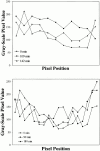Nuclear lamins A and B1: different pathways of assembly during nuclear envelope formation in living cells
- PMID: 11121432
- PMCID: PMC2190592
- DOI: 10.1083/jcb.151.6.1155
Nuclear lamins A and B1: different pathways of assembly during nuclear envelope formation in living cells
Abstract
At the end of mitosis, the nuclear lamins assemble to form the nuclear lamina during nuclear envelope formation in daughter cells. We have fused A- and B-type nuclear lamins to the green fluorescent protein to study this process in living cells. The results reveal that the A- and B-type lamins exhibit different pathways of assembly. In the early stages of mitosis, both lamins are distributed throughout the cytoplasm in a diffusible (nonpolymerized) state, as demonstrated by fluorescence recovery after photobleaching (FRAP). During the anaphase-telophase transition, lamin B1 begins to become concentrated at the surface of the chromosomes. As the chromosomes reach the spindle poles, virtually all of the detectable lamin B1 has accumulated at their surfaces. Subsequently, this lamin rapidly encloses the entire perimeter of the region containing decondensing chromosomes in each daughter cell. By this time, lamin B1 has assembled into a relatively stable polymer, as indicated by FRAP analyses and insolubility in detergent/high ionic strength solutions. In contrast, the association of lamin A with the nucleus begins only after the major components of the nuclear envelope including pore complexes are assembled in daughter cells. Initially, lamin A is found in an unpolymerized state throughout the nucleoplasm of daughter cell nuclei in early G1 and only gradually becomes incorporated into the peripheral lamina during the first few hours of this stage of the cell cycle. In later stages of G1, FRAP analyses suggest that both green fluorescent protein lamins A and B1 form higher order polymers throughout interphase nuclei.
Figures











References
-
- Benavente R., Krohne G., Franke W.W. Cell type-specific expression of nuclear lamina proteins during development of Xenopus laevis . Cell. 1985;41:177–190. - PubMed
-
- Bodoor K., Shaikh S., Salina D., Raharjo W.H., Bastos R., Lohka M., Burke B. Sequential recruitment of NPC proteins to the nuclear periphery at the end of mitosis. J. Cell Sci. 1999;112:2253–2264. - PubMed
-
- Bridger J.M., Kill I.R., O'Farrell M., Hutchison C.J. Internal lamin structures within G1 nuclei of human dermal fibroblasts. J. Cell Sci. 1993;104:297–306. - PubMed
-
- Broers J.L., Machiels B.M., van Eys G.J., Kuijpers H.J., Manders E.M., van Driel R., Ramaekers F.C. Dynamics of the nuclear lamina as monitored by GFP-tagged A-type lamins. J. Cell Sci. 1999;112:3463–3475. - PubMed
-
- Burke B., Gerace L.A. A cell free system to study reassembly of the nuclear envelope at the end of mitosis. Cell. 1986;44:639–652. - PubMed
Publication types
MeSH terms
Substances
Grants and funding
LinkOut - more resources
Full Text Sources
Other Literature Sources
Research Materials
Miscellaneous

